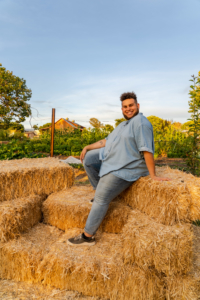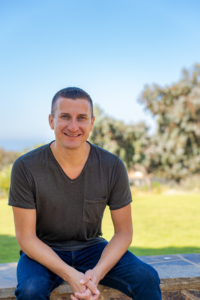Tu B’Shvat, or the Jewish New Year of the Trees, is observed on the 15th of the Hebrew month Shvat. This holiday is an agricultural festival marking the end of the rainy season and the arrival of spring in the Land of Israel. Tu B’Shvat is considered a festival of joy and gratitude for creation. During this festival, Jewish communities renew their commitment to care for the world and share the fruits of the earth with all. Many Jews enjoy eating from the seven species associated with the Land of Israel: wheat, barley, grapes, figs, pomegranates, olives, and dates. Kabbalists (Jewish mystics) even created a seder for Tu B’Shvat, similar to that of Passover. This day has also become an occasion for tree-planting in Israel, where Israelis and Jews around the world plant trees in honor of loved ones.
Trees have special meaning in Judaism. They symbolize life, as well as the transition from generation to generation. Trees take a central role in biblical stories, and the Torah itself is even referred to as the “tree of life.” The mitzvah (good deed) of lo tash’chit expresses the idea that we should feel for trees as we do people. Like humans, trees are divine creations, and should be treated as such. As we celebrate the renewal of trees and the essential role they play in our lives, we can also learn a valuable lesson from their behavior.
Since Darwin, we have generally thought of trees as individual, competing with each other for water, nutrients, and sunlight, with the strong outgrowing the weak and winning the bulk, if not all, of the available resources.
Recent scientific evidence now that refutes that idea. Researchers have found that, instead of competing, trees of the same species are communal, and will often form alliances with trees of other species. Trees within forests have come to live in cooperative, interdependent relationships, maintained by communication and a collective intelligence, similar to that of insect colonies.
Nearly 150 species of trees form root grafts with each other to exchange nutrients. They also use them to communicate. Trees will send distress signals to each other, warning of impending dangers such as drought, disease, and insect attacks. Trees receiving the message will subsequently adjust their behavior.
For young saplings in deeply shaded parts of the forest, as well as for larger trees lacking access to resources, this communal network is a literal lifeline. Even without adequate sunlight, saplings can grow as a result of taller trees passing nutrients to their roots. A tree with a sufficient source of water can share with a neighboring tree living in drier soil. Scientists call this hydraulic coupling. Just as we assist others in the community who are in need, so do trees.
This communal life of trees mirrors an interesting aspect of the human psyche – abundance mindset versus scarcity mindset. In a scarcity mindset, resources are finite, whereas in an abundance mindset, there are enough resources to support everyone’s success. A scarcity mindset sees life is a zero-sum game; if someone else does well, it must be at the expense of another. An abundance mindset sees the opportunity for conditions to be win-win. In abundance, there is enough for everyone to thrive, and success in a community can be for all.
One might look at a forest of ten thousand trees as a city of ten thousand people – every individual in competition with one another, only a few destined to succeed. What we actually see is that a forest of trees succeeds because their behavior is the opposite. Individually, they act in ways that perpetuate a communal flow of abundance to all.
Like trees, we can continue the flow of abundance by sharing that abundance. When we use philanthropy to distribute resources, we ensure that every single being has what they need to succeed. Jewish Kabbalists saw a deep significance in giving. They believed that expressing gratitude before eating from a tree is a blessing. Even more so a blessing is to feed others from that tree, because, through giving, the flow of abundance becomes constant and unceasing. Abundance is for all.
Hanz Enyeart, Events and Communications Associate







 Stacie and Jeff Cook understand commitment. They live it.
Stacie and Jeff Cook understand commitment. They live it. Black, Jewish and Queer. These three identities weave the fabric of who I am, but it took a long time to believe that they could exist together.
Black, Jewish and Queer. These three identities weave the fabric of who I am, but it took a long time to believe that they could exist together. Lee and Toni Leichtag established the Leichtag Foundation in 1991 following the sale of their business. Lee and Toni were lifelong entrepreneurs with a passion for innovation and for supporting talent. They believed that only with big risk comes big reward. Both born to families in poverty, Toni to a single mother, they strongly believed in helping those most in need and most vulnerable in our community. While they supported many causes, their strongest support was for young children and the elderly, two demographics who particularly lack voice in our society.
Lee and Toni Leichtag established the Leichtag Foundation in 1991 following the sale of their business. Lee and Toni were lifelong entrepreneurs with a passion for innovation and for supporting talent. They believed that only with big risk comes big reward. Both born to families in poverty, Toni to a single mother, they strongly believed in helping those most in need and most vulnerable in our community. While they supported many causes, their strongest support was for young children and the elderly, two demographics who particularly lack voice in our society. Lifelong Baltimoreans, Rabbi George and Alison Wielechowski and their sons, 11-year-old Lennon and 9-year-old Gideon, are more than pursuing the good life in Southern California. Having moved to San Diego more than three years ago, they are fulfilling a lifelong dream.
Lifelong Baltimoreans, Rabbi George and Alison Wielechowski and their sons, 11-year-old Lennon and 9-year-old Gideon, are more than pursuing the good life in Southern California. Having moved to San Diego more than three years ago, they are fulfilling a lifelong dream.





 You would think that as the executive director of San Diego LGBT Pride, Fernando Zweifach López Jr., who uses the pronoun they, has done all the coming out they possibly can. A queer, non-binary individual who has worked for many years on civil rights issues, López also speaks openly and often about their father’s family, Mexican-American migrant workers who tilled the fields of rural California.
You would think that as the executive director of San Diego LGBT Pride, Fernando Zweifach López Jr., who uses the pronoun they, has done all the coming out they possibly can. A queer, non-binary individual who has worked for many years on civil rights issues, López also speaks openly and often about their father’s family, Mexican-American migrant workers who tilled the fields of rural California.